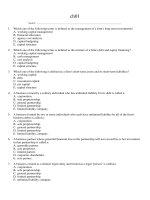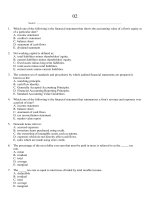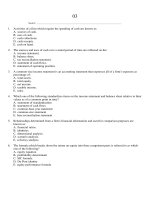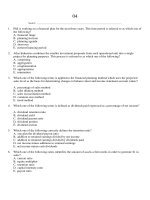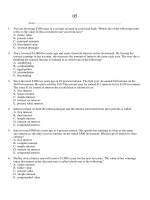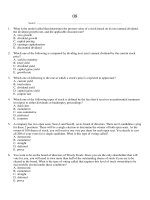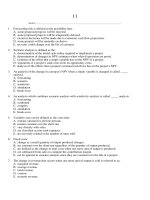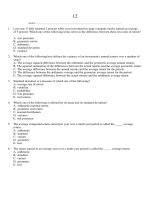fundamentals of analytical chemistry 9th edition pdf
Bạn đang xem bản rút gọn của tài liệu. Xem và tải ngay bản đầy đủ của tài liệu tại đây (26.5 MB, 1,088 trang )
www.TechnicalBooksPDF.com
The pH ranges shown are approximate.
Specific transition ranges depend on the
indicator solvent chosen.
Reprinted by permission of the Hach Company
www.TechnicalBooksPDF.com
Unless otherwise noted, all content on this page is © Cengage Learning.
PERIODIC TABLE OF THE ELEMENTS
Metals
IA
1
Metalloids
1
1
2
3
4
5
6
7
VIIA
17
Nonmetals
0
18
1
2
IIIA
13
IVA
14
VA
15
VIA
16
H
He
1.008
IIA
2
1.008
4.0026
3
4
5
6
7
8
9
10
Li
Be
B
C
N
O
F
Ne
6.941
9.0122
10.81
12.011
14.007
15.999
18.9984
20.1797
H
11
12
Na
Mg
22.9898
13
14
15
16
17
18
IIB
12
Al
Si
P
S
Cl
Ar
10
IB
11
26.9815
28.085
30.9738
32.06
35.453
39.948
27
28
29
30
31
32
33
34
35
36
Fe
Co
Ni
Cu
Zn
Ga
Ge
As
Se
Br
Kr
55.845
58.9332
58.6934
63.546
65.38
69.723
72.63
74.9216
78.96
79.904
83.798
VIIIB
24.3050
IIIB
3
IVB
4
VB
5
VIB
6
VIIB
7
8
9
19
20
21
22
23
24
25
26
K
Ca
Sc
Ti
V
Cr
Mn
39.0983
40.078
44.9559
47.867
50.9415
51.9961
54.9380
37
38
39
40
41
42
43
44
45
46
47
48
49
50
51
52
53
54
Rb
Sr
Y
Zr
Nb
Mo
Tc
Ru
Rh
Pd
Ag
Cd
In
Sn
Sb
Te
I
Xe
85.4678
87.62
88.9058
91.224
92.9064
95.96
(98)
101.07
102.9055
106.42
107.8682
112.411
114.818
118.710
121.760
127.60
126.9045
131.293
55
56
57
Cs
Ba
La
72
73
74
75
76
77
78
79
80
81
82
83
84
85
86
Hf
Ta
W
Re
Os
Ir
Pt
Au
Hg
Tl
Pb
Bi
Po
At
Rn
132.9055
137.327
87
88
138.9055
178.49
180.9479
183.84
186.207
190.23
192.217
195.084
196.9666
200.59
204.38
207.2
208.9804
(209)
(210)
(222)
89
104
105
106
107
108
109
110
111
112
113
114
115
116
117
Fr
Ra
Ac
118
Rf
Db
Sg
Bh
Hs
Mt
Ds
Rg
Cn
Uut
Fl
Uup
Lv
Uus
Uuo
(223)
(226)
(227)
(265)
(268)
(271)
(270)
(277)
(276)
(281)
(280)
(285)
(284)
(289)
(288)
(293)
(294)
(294)
*
**
*Lanthanide Series
Note: Atomic masses are 2009
IUPAC values (up to four decimal
places). More accurate values for
some elements are given in the
table inside the back cover.
58
59
60
61
62
63
64
65
66
67
68
69
70
71
Ce
Pr
Nd
Pm
Sm
Eu
Gd
Tb
Dy
Ho
Er
Tm
Yb
Lu
140.116
140.9076
144.242
(145)
150.36
151.964
157.25
158.9254
162.500
164.9303
167.259
168.9342
173.054
174.9668
** Actinide Series
90
91
92
93
94
95
96
97
98
99
100
101
102
103
Th
Pa
U
Np
Pu
Am
Cm
Bk
Cf
Es
Fm
Md
No
Lr
(237)
(244)
(243)
(247)
(247)
(251)
(252)
(257)
(258)
(259)
(262)
232.0381 231.0359 238.0289
www.TechnicalBooksPDF.com
International Atomic Masses
Element
Actinium
Aluminum
Americium
Antimony
Argon
Arsenic
Astatine
Barium
Berkelium
Beryllium
Bismuth
Bohrium
Boron
Bromine
Cadmium
Calcium
Californium
Carbon
Cerium
Cesium
Chlorine
Chromium
Cobalt
Copernicium
Copper
Curium
Darmstadtium
Dubnium
Dysprosium
Einsteinium
Erbium
Europium
Fermium
Flerovium
Fluorine
Francium
Gadolinium
Gallium
Germanium
Gold
Hafnium
Hassium
Helium
Holmium
Hydrogen
Indium
Iodine
Iridium
Iron
Krypton
Lanthanum
Lawrencium
Lead
Lithium
Livermorium
Lutetium
Magnesium
Manganese
Meitnerium
Symbol
Atomic
Number
Atomic
Mass
Ac
Al
Am
Sb
Ar
As
At
Ba
Bk
Be
Bi
Bh
B
Br
Cd
Ca
Cf
C
Ce
Cs
Cl
Cr
Co
Cn
Cu
Cm
Ds
Db
Dy
Es
Er
Eu
Fm
Fl
F
Fr
Gd
Ga
Ge
Au
Hf
Hs
He
Ho
H
In
I
Ir
Fe
Kr
La
Lr
Pb
Li
Lv
Lu
Mg
Mn
Mt
89
13
95
51
18
33
85
56
97
4
83
107
5
35
48
20
98
6
58
55
17
24
27
112
29
96
110
105
66
99
68
63
100
114
9
87
64
31
32
79
72
108
2
67
1
49
53
77
26
36
57
103
82
3
116
71
12
25
109
(227)
26.9815386
(243)
121.760
39.948
74.92160
(210)
137.327
(247)
9.012182
208.98040
(270)
10.81
79.904
112.411
40.078
(251)
12.011
140.116
132.90545
35.45
51.9961
58.933195
(285)
63.546
(247)
(281)
(268)
162.500
(252)
167.259
151.964
(257)
(289)
18.9984032
(223)
157.25
69.723
72.63
196.966569
178.49
(277)
4.002602
164.93032
1.008
114.818
126.90447
192.217
55.845
83.798
138.90547
(262)
207.2
6.94
(293)
174.9668
24.3050
54.938045
(276)
Element
Mendelevium
Mercury
Molybdenum
Neodymium
Neon
Neptunium
Nickel
Niobium
Nitrogen
Nobelium
Osmium
Oxygen
Palladium
Phosphorus
Platinum
Plutonium
Polonium
Potassium
Praseodymium
Promethium
Protactinium
Radium
Radon
Rhenium
Rhodium
Roentgenium
Rubidium
Ruthenium
Rutherfordium
Samarium
Scandium
Seaborgium
Selenium
Silicon
Silver
Sodium
Strontium
Sulfur
Tantalum
Technetium
Tellurium
Terbium
Thallium
Thorium
Thulium
Tin
Titanium
Tungsten
Ununoctium
Ununpentium
Ununseptium
Ununtrium
Uranium
Vanadium
Xenon
Ytterbium
Yttrium
Zinc
Zirconium
Symbol
Atomic
Number
Atomic
Mass
Md
Hg
Mo
Nd
Ne
Np
Ni
Nb
N
No
Os
O
Pd
P
Pt
Pu
Po
K
Pr
Pm
Pa
Ra
Rn
Re
Rh
Rg
Rb
Ru
Rf
Sm
Sc
Sg
Se
Si
Ag
Na
Sr
S
Ta
Tc
Te
Tb
Tl
Th
Tm
Sn
Ti
W
Uuo
Uup
Uus
Uut
U
V
Xe
Yb
Y
Zn
Zr
101
80
42
60
10
93
28
41
7
102
76
8
46
15
78
94
84
19
59
61
91
88
86
75
45
111
37
44
104
62
21
106
34
14
47
11
38
16
73
43
52
65
81
90
69
50
22
74
118
115
117
113
92
23
54
70
39
30
40
(258)
200.59
95.96
144.242
20.1797
(237)
58.6934
92.90638
14.007
(259)
190.23
15.999
106.42
30.973762
195.084
(244)
(209)
39.0983
140.90765
(145)
231.03588
(226)
(222)
186.207
102.90550
(280)
85.4678
101.07
(265)
150.36
44.955912
(271)
78.96
28.085
107.8682
22.98976928
87.62
32.06
180.94788
(98)
127.60
158.92535
204.38
232.03806
168.93421
118.710
47.867
183.84
(294)
(288)
(294)
(284)
238.02891
50.9415
131.293
173.054
88.90585
65.38
91.224
The values given in parentheses are the atomic mass numbers of the isotopes of the longest known half-life. From M. E. Wieser and T. B.
Coplen, Pure Appl. Chem., 2011, 83(2), 359–96, DOI: 10.1351/PAC-REP-10-09-14.
www.TechnicalBooksPDF.com
Molar Mass
AgBr
AgCl
Ag2CrO4
AgI
AgNO3
AgSCN
Al2O3
Al2(SO4)3
As2O3
B2O3
BaCO3
BaCl2 ? 2H2O
BaCrO4
Ba(IO3)2
Ba(OH)2
BaSO4
Bi2O3
CO2
CaCO3
CaC2O4
CaF2
CaO
CaSO4
Ce(HSO4)4
CeO2
Ce(SO4)2
(NH4)2Ce(NO3)6
(NH4)4Ce(SO4)4 ? 2H2O
Cr2O3
CuO
Cu2O
CuSO4
Fe(NH4)2(SO4)2 ? 6H2O
FeO
Fe2O3
Fe3O4
HBr
HC2H3O2 (acetic acid)
HC7H5O2 (benzoic acid)
(HOCH2)3CNH2 (TRIS)
HCl
HClO4
H2C2O4 ? 2H2O
H5IO6
HNO3
H2O
H2O2
H3PO4
H2S
H2SO3
H2SO4
HgO
Hg2Cl2
HgCl2
KBr
KBrO3
KCl
KClO3
KCN
K2CrO4
K2Cr2O7
187.772
143.32
331.729
234.7727
169.872
165.95
101.960
342.13
197.840
69.62
197.335
244.26
253.319
487.130
171.341
233.38
465.958
44.009
100.086
128.096
78.075
56.077
136.13
528.37
172.114
332.23
548.22
632.53
151.989
79.545
143.091
159.60
392.13
71.844
159.687
231.531
80.912
60.052
122.123
121.135
36.46
100.45
126.064
227.938
63.012
18.015
34.014
97.994
34.08
82.07
98.07
216.59
472.08
271.49
119.002
166.999
74.55
122.55
65.116
194.189
294.182
nds
Molar Masses of Some Compou
Compound
Compound
Molar Mass
K3Fe(CN)6
K4Fe(CN)6
KHC8H4O4 (phthalate)
KH(IO3)2
K2HPO4
KH2PO4
KHSO4
KI
KIO3
KIO4
KMnO4
KNO3
KOH
KSCN
K2SO4
La(IO3)3
Mg(C9H6NO)2
(8-hydroxyquinolate)
MgCO3
MgNH4PO4
MgO
Mg2P2O7
MgSO4
MnO2
Mn2O3
Mn3O4
Na2B4O7 ? 10H2O
NaBr
NaC2H3O2
Na2C2O4
NaCl
NaCN
Na2CO3
NaHCO3
Na2H2EDTA ? 2H2O
Na2O2
NaOH
NaSCN
Na2SO4
Na2S2O3 ? 5H2O
NH4Cl
(NH4)2C2O4 ? H2O
NH4NO3
(NH4)2SO4
(NH4)2S2O8
NH4VO3
Ni(C4H7O2N2)2
(dimethylglyoximate)
PbCrO4
PbO
PbO2
PbSO4
P2O5
Sb2S3
SiO2
SnCl2
SnO2
SO2
SO3
Zn2P2O7
329.248
368.346
204.222
389.909
174.174
136.084
136.16
166.0028
214.000
229.999
158.032
101.102
56.105
97.18
174.25
663.610
312.611
www.TechnicalBooksPDF.com
84.313
137.314
40.304
222.551
120.36
86.936
157.873
228.810
381.36
102.894
82.034
133.998
58.44
49.008
105.988
84.006
372.238
77.978
39.997
81.07
142.04
248.17
53.49
142.111
80.043
132.13
228.19
116.978
288.917
323.2
223.2
239.2
303.3
141.943
339.70
60.083
189.61
150.71
64.06
80.06
304.70
Excel Shortcut Keystrokes for the PC*
*Macintosh equivalents, if different, appear in square brackets
TO ACCOMPLISH THIS TASK
TYPE THESE KEYSTROKES
Alternate between displaying cell values and displaying cell
formulas
Calculate all sheets in all open workbooks
Calculate the active worksheet
Cancel an entry in a cell or formula bar
Complete a cell entry and move down in the selection
Complete a cell entry and move to the left in the selection
Complete a cell entry and move to the right in the selection
Complete a cell entry and move up in the selection
Copy a formula from the cell above the active cell into the cell
or the formula bar
Copy a selection
Copy the value from the cell above the active cell into the cell
or the formula bar
Cut a selection
Define a name
Delete the character to the left of the insertion point,
or delete the selection
Delete the character to the right of the insertion point,
or delete the selection
Displays the Insert Function dialog box
Displays Key Tips for ribbon shortcuts
Edit a cell comment
Edit the active cell
Edit the active cell and then clear it, or delete the preceding
character in the active cell as you edit the cell contents
Enter a formula as an array formula
Fill down
Fill the selected cell range with the current entry
Fill to the right
Format cells dialog box
Insert the AutoSum formula
Move one character up, down, left, or right
Move to the beginning of the line
Paste a name into a formula
Paste a selection
Repeat the last action
Selects the entire worksheet
Start a formula
Start a new line in the same cell
Undo
Ctrl1` [z1`]
F9
Shift1F9
Esc
Enter [Return]
Shift1Tab
Tab
Shift1Enter
Ctrl1’ (Apostrophe) [z1’]
Ctrl1C[z+C]
Ctrl1Shift1” (Quotation Mark) [z1Shift1”]
Ctrl1X [z1X]
Ctrl1F3 [z1F3]
Backspace [Delete]
Delete [Del]
Shift1F3
ALT
Shift1F2
F2 [None]
Backspace [Delete]
Ctrl1Shift1Enter
Ctrl1D[z1D]
Ctrl1Enter [None]
Ctrl1R [z1R]
Ctrl11 [z11]
Alt15 (Equal Sign) [z1Shift1T]
Arrow Keys
Home
F3 [None]
Ctrl1V [z1V]
F4 Or Ctrl1Y [z1Y]
Ctrl1A
5 (Equal Sign)
Alt1Enter [z1Option1Enter]
Ctrl1Z[z1Z]
www.TechnicalBooksPDF.com
Microsoft® Excel Ribbon and Tabs for Excel 2010
Home Ribbon Wide View
Home Ribbon Narrow View
Insert Tab
Formulas Tab
Data Tab
Not shown are Page Layout, Review and View Tabs
www.TechnicalBooksPDF.com
Charles D. Winters
H2O 1 I32(aq) 1 H3AsO3(aq) S
(a)
d 3I2(aq) 1 H3AsO4(aq) 1 H1(aq)
(b)
Charles D. Winters
Color Plate 1 Chemical Equilibrium 1: Reaction between iodine and
arsenic(III) at pH 1. (a) One mmol I3− added to one mmol H3AsO3.
(b) Three mmol I− added to one mmol H3AsO4. Both combinations of
solutions produce the same final equilibrium state (see Section 9B-1, page 202).
H2O 1 I32(aq) 1 H3AsO3(aq) S
(a)
d 3I2(aq) 1 H3AsO4(aq) 1 H1(aq)
(b)
Charles D. Winters
Color Plate 2 Chemical Equilibrium 2: The same reaction as in color
plate 1 carried out at pH 7, producing a different equilibrium state than that
in Color Plate 1, and although similar to the situation in Color Plate 1, the
same state is produced from either the forward (a) or the reverse (b) direction
(see Section 9B-1, page 202).
I32(aq) 1 2Fe(CN)64−(aq) S
(a)
d 3I2(aq) 1 2Fe(CN)63− (aq)
(b)
Color Plate 3 Chemical Equilibrium 3: Reaction between iodine and
ferrocyanide. (a) One mmol I3− added to two mmol Fe(CN)642. (b) Three
mmol I− added to two mmol Fe(CN)632. Both combinations of solutions
produce the same final equilibrium state. (see Section 9B-1, page 202).
www.TechnicalBooksPDF.com
Charles D. Winters
Charles D. Winters
Charles D. Winters
Charles D. Winters
Charles D. Winters
Color Plate 5 Crystallization of sodium acetate from
a supersaturated solution (see Section 12A-2, page 280).
A tiny seed crystal is dropped into the center of a petri dish
containing a supersaturated solution of the compound.
The time sequence of photos taken about once per second
shows the growth of the beautiful crystals of sodium acetate.
Charles D. Winters
Color Plate 4 The common-ion effect.
The test tube on the left contains a saturated
solution of silver acetate, AgOAc. The following
equilibrium is established in the test tube:
AgOAc(s) 8 Ag+(aq) + OAc−(aq)
www.TechnicalBooksPDF.com
When AgNO3 is added to the test tube, the
equilibrium shifts to the left to form more
AgOAc, as shown in the test tube on the right
(see Section 9B-5, page 209).
Charles D. Winters
Color Plate 6 The Tyndall effect. The photo shows
two cuvettes: the one on the left contains only water while
the one on the right contains a solution of starch. As red
and green laser beams pass through the water in the left
cuvette, they are invisible. Colloidal particles in the starch
solution in the right cuvette scatter the light from the two
lasers, so the beams become visible (see Section 12A-2,
margin note, page 280).
Charles D. Winters
Color Plate 7 When dimethylglyoxime
is added to a slightly basic solution of
Ni21(aq), shown on the left, a bright red
precipitate of Ni(C4H7N2O2)2 is formed
as seen in the beaker on the right
(see Section 12C-3, page 294).
www.TechnicalBooksPDF.com
1 2 3 4 5 6 7 8 9 10 11 12
pH
Methyl violet (0.0–1.6)
Chlorophenol red (4.8–6.7)
1 2 3 4 5 6 7 8 9 10 11 12
pH
1 2 3 4 5 6 7 8 9 10 11 12
pH
m-Cresol purple (7.4–9.0)
Bromophenol blue (3.0–4.6)
1 2 3 4 5 6 7 8 9 10 11 12
pH
1 2 3 4 5 6 7 8 9 10 11 12
pH
Methyl orange (3.2–4.4)
Thymol blue (8.0–9.2)
1 2 3 4 5 6 7 8 9 10 11 12
pH
1 2 3 4 5 6 7 8 9 10 11 12
pH
Bromocresol green (3.8–5.4)
Phenolphthalein (8.0–10.0)
1 2 3 4 5 6 7 8 9 10 11 12
pH
Alizarin red (4.6–6.0)
Charles D. Winters
1 2 3 4 5 6 7 8 9 10 11 12
pH
1 2 3 4 5 6 7 8 9 10 11 12
pH
o-Cresolphthalein (8.2–9.8)
1 2 3 4 5 6 7 8 9 10 11 12
pH
Bromothymol (6.0–7.0)
1 2 3 4 5 6 7 8 9 10 11 12
pH
Thymolphthalein (8.8–10.5)
Color Plate 8 Acid/base indicators and their transition pH ranges (see Section 14A-2, page 323).
www.TechnicalBooksPDF.com
Charles D. Winters
Charles D. Winters
Charles D. Winters
Charles D. Winters
Color Plate 11 A modern version of the Daniell Cell
(see Feature 18-2, page 450).
Color Plate 12 Reaction between Iron(III) and
iodide. The species in each beaker are indicated by
the colors of the solutions. Iron (III) is pale yellow,
iodide is colorless, and triiodide is intense red-
orange (see margin note, Section 18C-6, page 464).
Color Plate 13 The time dependence of the reaction between permanganate and oxalate (see Section 20C-1, page 515).
www.TechnicalBooksPDF.com
Charles D. Winters
Charles D. Winters
2Fe31 1 3I2 8 2Fe21 1 I32
Charles D. Winters
Color Plate 10 Reduction of
silver(I) by direct reaction with
copper, forming the “silver tree”
(see Section 18A-2, page 445).
Color Plate 9 End point in an acid/base titration with phenolphthalein as
indicator. The end point is achieved when the barely perceptible pink color of
phenolphthalein persists. The flask on the left shows the titration less than half a
drop prior to the end point; the middle flask shows the end point. The flask on
the right shows what happens when a slight excess of base is added to the titration mixture. The solution turns a deep pink color, and the end point has been
exceeded (see Section 13A-1, page 304).
© H&H Productions
(b)
Simon Tulloch
Simon Tulloch
(a)
(c)
Charles D. Winters
Color Plate 14 (a) Typical linear CCD arrays for spectrophotometers. The array on the right has 4096 pixels, and the
array on the left has 2048 pixels. In both arrays, each pixel has the dimensions of 14 mm 3 14 mm. These devices have a
spectral range of 200-1000 nm, a dynamic range of 2500:1 (see Section 8E-2), and are available with low-cost glass or
UV-enhanced fused silica windows. In addition to the sizes shown, the arrays are available in lengths of 512 and 1024 pixels.
(b) Photomicrograph of a section of a two-dimensional CCD array that is used for imaging and spectroscopy. Light falling
on the millions of pixels in the upper left of the photo creates charge that is transferred to the vertical channels at the
bottom of the photo and shifted from left to right along the string of channels until it reaches the output amplifier section
shown in (c). The amplifier provides a voltage proportional to the charge accumulated on each pixel, which is in turn
proportional to the intensity of light falling on the pixel (see Section 25A-4, page 705, for a discussion of charge-transfer
devices).
Color Plate 15 Series of standards (left) and two
unknowns (right) for the spectrophotometric determination of Fe(II) using 1,10-phenanthroline as reagent
(see Section 26A-3 and Problem 26-26, page 757).
The color is due to the complex Fe(phen)32+.
The absorbance of the standards is measured, and a
working curve is analyzed using linear least-squares
(see Section 8C-2, page 172). The equation for the
line is then used to determine the concentrations of the
unknown solutions from their measured absorbances.
www.TechnicalBooksPDF.com
Visible Spectrum
380 400 420 440 460 480 500 520 540 560 580 600 620 640 660 680 700 720
Barium
380 400 420 440 460 480 500 520 540 560 580 600 620 640 660 680 700 720
Calcium
380 400 420 440 460 480 500 520 540 560 580 600 620 640 660 680 700 720
Chromium
380 400 420 440 460 480 500 520 540 560 580 600 620 640 660 680 700 720
Europium
380 400 420 440 460 480 500 520 540 560 580 600 620 640 660 680 700 720
Indium
380 400 420 440 460 480 500 520 540 560 580 600 620 640 660 680 700 720
Iron
380 400 420 440 460 480 500 520 540 560 580 600 620 640 660 680 700 720
Lithium
380 400 420 440 460 480 500 520 540 560 580 600 620 640 660 680 700 720
Sodium
380 400 420 440 460 480 500 520 540 560 580 600 620 640 660 680 700 720
Strontium
380 400 420 440 460 480 500 520 540 560 580 600 620 640 660 680 700 720
Thallium
380 400 420 440 460 480 500 520 540 560 580 600 620 640 660 680 700 720
Vanadium
380 400 420 440 460 480 500 520 540 560 580 600 620 640 660 680 700 720
380 400 420 440 460 480 500 520 540 560 580 600 620 640 660 680 700 720
l, nm
Color Plate 16 Spectrum of white light and emission spectra of selected elements
(see Chapter 28).
www.TechnicalBooksPDF.com
Jim Holler
Ytterbium
400
410
420
430
440
450
460
460
470
480
490
500
510
520
520
530
540
550
560
570
580
580
590
600
610
620
630
640
640
650
660
670
680
690
700
l, nm
(a)
H
He
l
(a)
Color Plate 17 The solar spectrum. (a) Expanded color version of the solar spectrum
shown in black and white in Feature 24-1 (see Figure 24F-1, page 657). The huge number
of dark absorption lines are produced by all of the elements in the sun. See if you can
spot some prominent lines like the famous sodium doublet. (b) Compact version of the
solar spectrum in (a) compared to the emission spectra of hydrogen, helium, and iron.
It is relatively easy to spot lines in the emission spectra of hydrogen and iron that
correspond to absorption lines in the solar spectrum, but the lines of helium are quite
obscure. In spite of this problem, helium was discovered when these lines were observed
in the solar spectrum (see Section 28D). (Images created by Dr. Donald Mickey,
University of Hawaii Institute for Astronomy from National Solar Observatory spectral
data/NSO/Kitt Peak FTS data by NSF/NOAO.)
www.TechnicalBooksPDF.com
(Dr. Donald Mickey)
Fe
Charles D. Winters
Color Plate 18 (a) Demonstration
of atomic absorption by mercury vapor.
(b) White light from the source on the
right passes through the mercury vapor
above the flask and no shadow appears
on the fluorescent screen on the left.
Light from the mercury lamp on the
left containing the characteristic UV
lines of the element is absorbed by the
vapor in and above the flask, which casts
a shadow on the screen on the right of
the plume of mercury vapor (see Section
28D-4, page 797).
(a)
Fluorescent screen
Shadow
Mercury vapor
Mercury vapor lamp
White light source
Jim Holler
Liquid
mercury
(b)
www.TechnicalBooksPDF.com
Charles D. Winters
Charles D. Winters
(c)
(b)
Charles D. Winters
(d)
(e)
Color Plate 19 Weighing by
difference the old-fashioned way.
(a) Zero the balance. (b) Place a
weighing bottle containing the
solute on the balance pan. (c) Read
the mass (33.2015 g). (d) Transfer
the desired amount of solute to a flask.
(e) Replace the weighing bottle on the
pan and read the mass (33.0832 g).
Finally, calculate the mass of the
solute transferred to the flask:
33.2015 g 2 33.0832 g 5 0.1131 g
(see Section 2E-4, page 27).
(Electronic balance provided by
Mettler-Toledo, Inc.)
Charles D. Winters
(a)
Charles D. Winters
www.TechnicalBooksPDF.com
(c)
(b)
Charles D. Winters
Charles D. Winters
Charles D. Winters
(a)
Charles D. Winters
(d)
www.TechnicalBooksPDF.com
Color Plate 20 Weighing by difference the modern way. Place a weighing
bottle containing the solute on the
balance pan and (a) depress the tare
or zero button. The balance should
then read 0.0000 g, as shown in (b).
(c) Transfer the desired amount of
solute to a flask. Replace the weighing
bottle on the pan, and (d) the balance
reads the decrease in mass directly as
20.1070 g (see Section 2E-4, page 27).
Many modern balances have built-in
computers with programs to perform a
variety of weighing tasks. For example,
it is possible to dispense many
consecutive quantities of a substance
and automatically read out the loss in
mass following each dispensing.
Many balances also have computer
intterfaces so that reading may be
logged directly to programs running
on the computer. (Electronic balance
provided by Mettler-Toledo, Inc.)
1019
Gamma
rays
10212
(1 pm)
1018
1017
X rays
10211
(10 pm)
10210
(100 pm)
1029
(1 nm)
1016
Far
ultraviolet
1028
(10 nm)
1015
Near
ultraviolet
1027
(100 nm)
1014
Visible
1020
1026
(1 mm)
1013
Near
infrared
1012
Far
infrared
1025
(10 mm)
1024
(100 mm)
1011
1010
Microwaves
1023
(1 mm)
1022
(10 mm)
Frequency (s21)
TV FM AM
Radio waves
Radar
Wavelength (m)
1021
(100 mm)
Visible spectrum
350
400
450
500
550
600
650
700
750
Color Plate 21 Electromagnetic spectrum. The spectrum extends from high-energy (frequency) gamma rays to low-energy (frequency) radio waves (see
Section 24B-1, page 654). Note that the visible region is only a tiny fraction of the spectrum. The visible region, broken out in the lower portion, e xtends
from the violet (≈380 nm) to the red region (≈800 nm). (Courtesy of Ebbing and Gammon, General Chemistry, 10th ed.)
www.TechnicalBooksPDF.com
800
nm
This is an electronic version of the print textbook. Due to electronic rights restrictions, some third party content may be suppressed. Editorial
review has deemed that any suppressed content does not materially affect the overall learning experience. The publisher reserves the right to
remove content from this title at any time if subsequent rights restrictions require it. For valuable information on pricing, previous
editions, changes to current editions, and alternate formats, please visit www.cengage.com/highered to search by
ISBN#, author, title, or keyword for materials in your areas of interest.
www.TechnicalBooksPDF.com
Fundamentals of
Analytical
Chemistry
Douglas A. Skoog
Stanford University
Donald M. West
San Jose State University
F. James Holler
University of Kentucky
Stanley R. Crouch
Michigan State University
Australia • Brazil • Japan • Korea • Mexico • Singapore • Spain • United Kingdom • United States
www.TechnicalBooksPDF.com
ninth Edition
Fundamentals of Analytical Chemistry,
Ninth Edition
Douglas A. Skoog, Donald M. West, F. James
Holler, Stanley R. Crouch
Publisher: Mary Finch
Acquisitions Editor: Chris Simpson
Developmental Editor: Sandra Kiselica
© 2014, 2004 Brooks/Cole, Cengage Learning
ALL RIGHTS RESERVED. No part of this work covered by the copyright herein
may be reproduced, transmitted, stored or used in any form or by any means
graphic, electronic, or mechanical, including but not limited to photocopying,
recording, scanning, digitizing, taping, Web distribution, information networks,
or information storage and retrieval systems, except as permitted under
Section 107 or 108 of the 1976 United States Copyright Act, without the prior
written permission of the publisher.
Assistant Editor: Alicia Landsberg
Media Editor: Rebecca Berardy Schwartz
Brand Manager: Nicole Hamm
Market Development Manager:
Janet del Mundo
Content Project Manager: Jennifer Risden
For product information and technology assistance, contact us at
Cengage Learning Customer & Sales Support, 1-800-354-9706
For permission to use material from this text or product,
submit all requests online at www.cengage.com/permissions
Further permissions questions can be emailed to
Art Director: Maria Epes
Manufacturing Planner: Judy Inouye
Library of Congress Control Number: 2012949970
Rights Acquisitions Specialist: Don Schlotman
ISBN-13: 978-0-495-55828-6
Production Service and Composition:
PreMediaGlobal
ISBN-10: 0-495-55828-1
Photo Researcher: Bill Smith Group
Brooks/Cole
20 Davis Drive
Belmont, CA 94002-3098
USA
Text Researcher: Isabel Saraiva
Copy Editor: PreMediaGlobal
Illustrator: Rolin Graphics, Inc.;
Nesbitt Graphics; PreMediaGlobal
Text and Cover Designer: Bill Reuter
Excel® screen captures are used courtesy of Microsoft Corporation.
Cover Image: John F. Barry
Interior Design Image: John F. Barry
Cengage Learning is a leading provider of customized learning solutions with
office locations around the globe, including Singapore, the United Kingdom,
Australia, Mexico, Brazil, and Japan. Locate your local office at:
www.cengage.com/global
Cengage Learning products are represented in Canada by Nelson Education, Ltd.
To learn more about Brooks/Cole, visit www.cengage.com/brookscole
Purchase any of our products at your local college store or at our preferred
online store www.cengagebrain.com
Printed in the United States of America
1 2 3 4 5 6 7 16 15 14 13 12
www.TechnicalBooksPDF.com
Contents in Brief
Chapter 1
The Nature of Analytical Chemistry 1
Part I Tools of Analytical Chemistry 14
Chapter 2
Chemicals, Apparatus, and Unit Operations of
Analytical Chemistry 15
Chapter 3
Using Spreadsheets in Analytical Chemistry 48
Chapter 4
Calculations Used in Analytical Chemistry 62
Chapter 5
Errors in Chemical Analyses 82
Chapter 6
Random Errors in Chemical Analysis 93
Chapter 7
Statistical Data Treatment and Evaluation 123
Chapter 8
Sampling, Standardization, and Calibration 153
Part II Chemical Equilibria 196
Chapter 9
Aqueous Solutions and Chemical Equilibria 197
Chapter 10 Effect of Electrolytes on Chemical Equilibria 235
Chapter 11 Solving Equilibrium Problems for
Complex Systems 249
Part III Classical Methods of Analysis 279
Chapter 12 Gravimetric Methods of Analysis 280
Chapter 13 Titrations in Analytical Chemistry 302
Chapter 14 Principles of Neutralization Titrations 322
Chapter 15 Complex Acid/Base Systems 348
Chapter 16 Applications of Neutralization Titrations 381
Chapter 17 Complexation and Precipitation Reactions
and Titrations 400
Part IV Electrochemical Methods 441
Chapter 18 Introduction to Electrochemistry 442
Chapter 19 Applications of Standard Electrode Potentials 473
Chapter 20 Applications of Oxidation/Reduction Titrations 509
Chapter 21 Potentiometry 535
Chapter 22 Bulk Electrolysis: Electrogravimetry and Coulometry 578
Chapter 23 Voltammetry 610
Part V Spectrochemical Methods 649
Chapter 24 Introduction to Spectrochemical Methods 650
Chapter 25 Instruments for Optical Spectrometry 683
Chapter 26 Molecular Absorption Spectrometry 722
Chapter 27 Molecular Fluorescence Spectroscopy 760
Chapter 28 Atomic Spectroscopy 773
Chapter 29 Mass Spectrometry 802
iii
www.TechnicalBooksPDF.com
iv Contents in Brief
Part VI Kinetics and Separations 818
Chapter 30 Kinetic Methods of Analysis 819
Chapter 31 Introduction to Analytical Separations 847
Chapter 32 Gas Chromatography 887
Chapter 33 High-Performance Liquid Chromatography 912
Chapter 34 Miscellaneous Separation Methods 935
Part VII Practical Aspects of Chemical Analysis 959
Part VII chapters are only available as an Adobe Acrobat® PDF file on the web at
www.cengage.com/chemistry/skoog/fac9.
Chapter 35
Chapter 36
Chapter 37
Chapter 38
The Analysis of Real Samples 960
Preparing Samples for Analysis 970
Decomposing and Dissolving the Sample 976
Selected Methods of Analysis 986
Glossary G-1
Appendix 1
Appendix 2
Appendix 3
Appendix 4
Appendix 5
Appendix 6
Appendix 7
Appendix 8
Appendix 9
The Literature of Analytical Chemistry A-1
Solubility Product Constants at 25°C A-6
Acid Dissociation Constants at 25°C A-8
Formation Constants at 25°C A-10
Standard and Formal Electrode Potentials A-12
Use of Exponential Numbers and Logarithms A-15
Volumetric Calculations Using Normality and Equivalent
Weight A-19
Compounds Recommended for the Preparation of Standard
Solutions of Some Common Elements A-27
Derivation of Error Propagation Equations A-29
Answers to Selected Questions and Problems A-34
Index I-1
www.TechnicalBooksPDF.com


